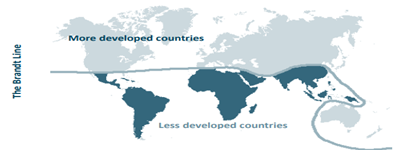

Context
Recently, the External Affairs Minister of India iterated the country’s role as the “voice of the Global South”, which is otherwise under-represented in global forums.
The Global North-South Divide
- In the 1980s, the Brandt Line was developed as a way of showing how the world was geographically split into relatively richer and poorer nations. According to this model:
- Richer countries are almost all located in the Northern Hemisphere, except for Australia and New Zealand.
- Poorer countries are mostly located in tropical regions and the Southern Hemisphere.
- Global North refers loosely to countries like the US, Canada, Europe, Russia, Australia, and New Zealand. Global South includes countries in Asia, Africa, and South America.
- Some the South countries like China and China have emerged economically, in the last few decades.
- The progress achieved by many Asian countries is also seen as challenging the idea that the North is the ideal.

Other categorizations:
- First World, Second World, and Third World Countries:
- First, Second, and Third Worlds countries refer to countries associated with the Cold war-era alliances of the US, the USSR, and non-aligned countries, respectively.
- The idea of the “third” world underlined that it was not only different from the “first” capitalist West but also the second socialist “East”.
- World Systems Approach:
- It emphasizes an interconnected perspective of looking at world politics. There are three major zones of production: core, peripheral and semi-peripheral.
- The core zones reap profits, being the owners of cutting-edge technologies – countries like the US or Japan.
- Peripheral zones, on the other hand, engage in less sophisticated production that is more labor-intensive.
- Semi-peripheral zone is in the middle including countries like India and Brazil.
- Eastern and Western Countries:
- Western countries generally signify greater levels of economic development and prosperity among their people.
- Eastern countries are considered as being in the process of that transition.
Factors that position India as the “Voice of the global south”:
- India harmonizes various interests that are ingrained deeply in India’s history and culture.
- Countries in Asia, Africa, and Latin America trust India to speak up for them.
- India has been at the forefront of expressing its concerns about fuel, food, and fertilizers.
- India acknowledges the fact, that sustainable development climate action and climate justice could be side-tracked due to more dominant issues.
- Global order today is not truly reflective of the state of the world. India has to take the lead in pushing for collective action.
- Institutions and practices created 75 years ago still dominate global decision-making.
- India supports the idea of introducing changes, not just in the United Nations but in other international institutions as well.
How can India be the Voice of the Global South?
- Championing the Global South today would demand more active Indian engagement with the messy regional politics within the developing world.
- India must also come to terms with the fact that the Global South is not a coherent group and does not have a single shared agenda. There is much differentiation within the South today in terms of wealth and power, needs and capabilities.
- This demands a tailored Indian policy for different regions and groups of the developing world.
- India is eager to become a bridge between the North and the South by focusing on practical outcomes rather than returning to old ideological battles. If India can translate this ambition into effective policy, there will be no contradiction between the simultaneous pursuit of universal and particular goals.



